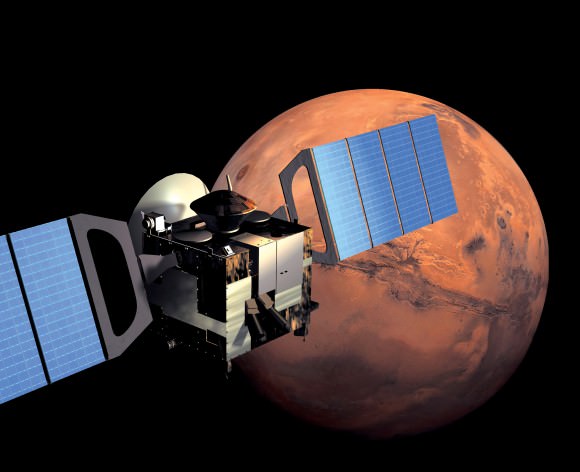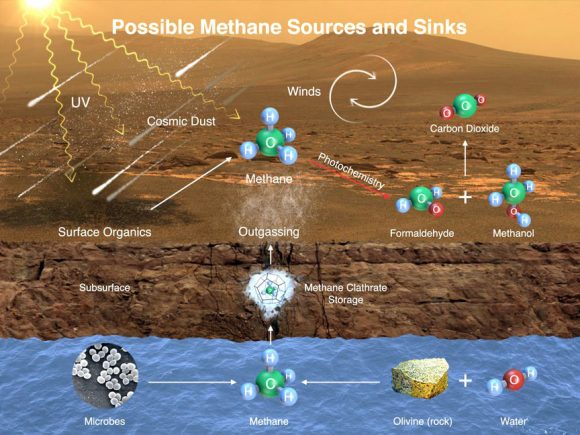In 2003, scientists from NASA’s Goddard Space Center made the first-ever detection of trace amounts of methane in Mars’ atmosphere, a find which was confirmed a year later by the ESA’s Mars Express orbiter. In December of 2014, the Curiosity rover detected a tenfold spike of methane at the base of Mount Sharp, and later uncovered evidence that Mars has a seasonal methane cycle, where levels peak in the late northern summer.
Since it’s discovery, the existence of methane on Mars has been considered one of the strongest lines of evidence for the existence of past or present life. So it was quite the downer last week (on Dec. 12th) when the science team behind one of the ESA’s ExoMars Trace Gas Orbiter (TGO) spectrometers announced that they had found no traces of methane in Mars’ atmosphere.
The announcement came during the 2018 Fall meeting of the American Geophysical Union, which took place from Dec. 10th to 14th, in Washington, D.C. At a presentation titled “Impact of the 2018 global dust storm on Mars atmosphere composition as observed by NOMAD on ExoMars Trace Gas Orbiter“, the science team behind the Nadir and Occultation for MArs Discovery (NOMAD) spectrometer presented results from the mission.

Arriving in orbit around Mars in 2016, one of the chief aims of the TGO mission was to scan the planet’s atmosphere for signs of methane. This task has been performed by two of the orbiter’s spectrometers – the NOMAD and the Atmospheric Chemistry Suite (ATS) – which were designed to detect methane in very low concentrations.
Given the sensitivity of these instruments, the science team was confident that if there was any methane to be found in Mars’ atmosphere, NOMAD and ATS would be able to sniff it out. However, the team’s initial results showed no detection of methane all the way down to the surface of Mars, even at the minute level of 50 parts per trillion.
According to Ann Carine Vandaele, a planetary scientist at the Royal Belgian Institute for Space Aeronomy and NOMAD’s principle investigator, their is still background noise to clean up from the results. However, both instruments are in working order and there appears to be no reason to doubt these preliminary findings.
According to Chris Webster, a planetary scientist at the Jet Propulsion Laboratory who leads the methane-sensing instrument on Curiosity, the previous levels detected mean that the TGO should have picked up a signal indicating a methane level of at least 0.2 parts per billion (ppb). For those hoping that evidence of past life (or present life) would be found on Mars in their lifetime, this certainly sounds like bad news.

Nevertheless, there are reasons to remain hopeful. For one, there is the matter of the hundreds of tons of organic carbon that are believed to pour into the Martian atmosphere every year from Solar System dust. Scientists have theorized that this carbon reacts with solar radiation to form methane. If there is in fact no methane in the atmosphere, then where is this carbon going?
Second, from what they have found in the past, Webster and his team suspect that Mars’ methane cycle comes in “microseeps” from subsurface sources (either from living or geological in nature) and not from outside the planet. The TGO results could be seen as a validation of that, since it found no trace of methane falling down through the atmosphere.
In addition, it took the Curiosity team 6 months to detect the tenfold methane spike in Mars’ atmosphere and years to detect the background methane cycle. So Webster strongly believes that finding the Martian methane is just a matter of time. “I’m confident that over time there will be a consistency between the two data sets,” he said. “The methane is not coming from above. That’s a big result.”
Naturally, Vandaele and her team still need to process the NOMAD data and further scans will be needed before these results can be considered definitive. And given the many previous instances where methane was detected, it seems unlikely that all the previous results were in error. Like the existence of life on Mars, the matter of the “missing methane” is likely to remain a mystery for the time being.

